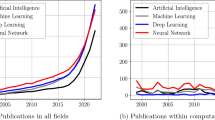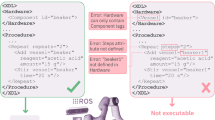Abstract
We subject a basic qualitative modelwhich appears throughout the qualitativereasoning literature (the ``bathtub'' or liquidtank model) to a detailed theoretical analysisof its representation properties. We show thatthe standard model for this family of systemsdoes not cover the intuitive concept ofreal-world tanks, in that there are both simpletanks that do not obey the model, and thatthere are physically impossible shapes that doobey it and get considered by qualitativereasoners using the model. We demonstrate thatthese modeling problems may lead to a markeddecrease in the usefulness of employingqualitative reasoners in some cases. Weconclude that one should be careful aboutmaking both the assumptions required by themodel and the algorithm, and the family ofsystems that are actually reasoned about,explicit in the presentation of qualitativereasoners' output.
Similar content being viewed by others
References
Catino, C. A. & Ungar, L. H. (1995). A Model-Based Approach to Automated Hazard Identification of Chemical Plants. Computers and Chemical Engineering 41: 97–109.
Clancy, D. J. (1997). Solving Complexity and Ambiguity Problems within Qualitative Simulation. Ph.D. diss., Department of Computer Sciences, The University of Texas at Austin.
Dalle Molle, D. T., Kuipers, B. J. & Edgar, T. F. (1988). Qualitative Modeling and Simulation of Dynamic Systems. Computers and Chemical Engineering 12: 835–866.
de Kleer, J. & Brown, J. S. (1984). A Qualitative Physics Based on Confluences. Artificial Intelligence 24: 7–83.
Forbus, K. D. (1984). Qualitative Process Theory. Artificial Intelligence 24: 85–168.
Gazi, E., Seider, W. D. & Ungar, L. H. (1997). A Non-Parametric Monte Carlo Technique for Controller Verification. Automatica 33: 901–906.
Halliday, D. & Resnick, R. (1978), Physics. John Wiley & Sons.
Ironi, L., Stefanelli, M. & Lanzola, G. (1990). Qualitative Models in Medical Diagnosis. Artificial Intelligence in Medicine 2: 85–101.
Kaul, N., Biswas, G. & Bhuva, B. (1994). An AI Approach to Multi-Level, Mixedmode Qualitative Simulation of CMOS ICs. Computers and Electrical Engineering, An International Journal 20: 369–382.
Kuipers, B. (1994). Qualitative Reasoning: Modeling and Simulation with Incomplete Knowledge. Cambridge, MA: MIT Press.
Kuipers B. & Åström, K. (1994). The Composition and Validation of Heterogeneous Control Laws. Automatica 30: 233–249.
Kuipers, B., Chiu, C., Dalle Molle, D. T. & Throop, D. (1991). Higher-Order Derivative Constraints in Qualitative Simulation. Artificial Intelligence 51: 343–379.
Lang, K. R., Moore, J. C. & Whinston, A. B. (1995). Computational Systems for Qualitative Economics. Computational Economics 8: 1–26.
Rowe, N. C. (1997). Obtaining Optimal Mobile-Robot Paths with Nonsmooth Anisotropic Cost Functions Using Qualitative-state Reasoning. Int. J. of Robotics Research 16: 375–399.
Say, A. C. C. & Kuru, S. (1996). Qualitative System Identification: Deriving Structure from Behavior. Artificial Intelligence 83: 75–141.
Shults, B. & Kuipers, B. (1997). Proving Properties of Continuous Systems: Qualitative Simulation and Temporal Logic. Artificial Intelligence 92: 91–129.
Trelease, R. B. & Park., J. (1996). Qualitative Process Modeling of Cell-Cell-Pathogen Interactions in the Immune System. Computer Methods and Programs in Biomedicine 51: 171–181.
Weld, D. S. & de Kleer, J. (eds.) (1990). Readings in Qualitative Reasoning About Physical Systems. San Mateo, CA: Morgan Kaufmann.
Williams, B. C. (1988). MINIMA: A Symbolic Approach to Qualitative Algebraic Reasoning. In Proceedings of the 7th National Conf. on Artificial Intelligence, 264–269. San Mateo, CA: Morgan Kaufmann.
Rights and permissions
About this article
Cite this article
Say, A.C. Problems in Representing Liquid Tankswith Monotonicity Constraints: A Case Study inModel-Imposed Limitations on the Coverage ofQualitative Simulators. Artificial Intelligence Review 17, 291–317 (2002). https://doi.org/10.1023/A:1015510017160
Issue Date:
DOI: https://doi.org/10.1023/A:1015510017160




